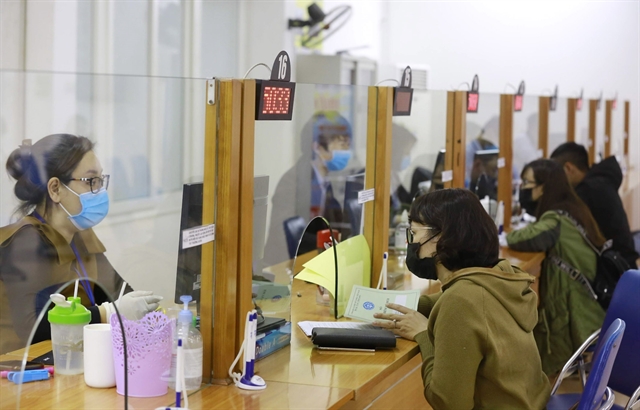 Society
Society

The pandemic has taken its toll on Việt Nam’s labour market conditions, according to the report “A crisis like no other: COVID-19 and labour markets in Southeast Asia - Evidences from Indonesia, Malaysia, the Philippines, Thailand, and Viet Nam” published on December 16 by the Asian Development Bank (ADB).

|
| Labourers complete unemployment procedures at the Hà Nội Employment Service Centre. — VNA/VNS Photo Anh Tuấn |
HÀ NỘI— The pandemic has taken its toll on Việt Nam’s labour market conditions, according to the report “A crisis like no other: COVID-19 and labour markets in Southeast Asia - Evidences from Indonesia, Malaysia, the Philippines, Thailand, and Viet Nam” published last week by the Asian Development Bank (ADB).
According to the report, Việt Nam’s unemployment rate (UR) increased by 0.3 per cent from 2.1 in Q1 to 2.4 in Q2 2021.
The country also saw its labour force participation rate (LFPR) and employment-to-population ratio (EPR) fall slightly in the same period, to 68.1 per cent and 66.5 per cent respectively.
Notably, when employment losses in Việt Nam peaked in Q2 2020 with 2.4 million people rendered jobless, only about 220,000 of these people joined the ranks of the unemployed, while the rest exited the labour force entirely. This means that nearly 91 per cent of those who lost their jobs in Q2 2020 quit looking for new jobs.
Youth were hit hard across the region and Việt Nam was no exception. By Q2 2021, the EPR for youth in the country has plunged by more than 12 per cent compared to its pre-crisis levels, standing at 39.9 per cent. Worse still, the UR for youth has reached the highest point since the onset of the pandemic.
Women were disproportionately affected as well, recording a greater share in job losses than their share in employment. In Việt Nam, they made up 47 per cent of the workforce and accounted for half of the net job losses. This disparity could be observed in manufacturing, financial intermediation and insurance, administrative and support services, human health, and other service activities.
Although the survey data for the second half of this year are unavailable, the ADB believe the labour market recovery, the prospects of which had seemed favourable at the end of 2020 in the region, suffered a major setback in 2021.
The ADB is concerned that the devastating impact of the Delta wave of the virus in 2021, coupled with a slow vaccination rollout, has required further containment measures and derailed, or at least delayed, recovery.
The development bank thus suggests countries in the regions shift fiscal policies more strongly from relief to stimulus, and from stimulus to structural investments as soon as recovery set in.
According to the recent report on labour and employment in Q3 2021 published by the General Statistics Office of Việt Nam, out of more than 28.2 million people negatively impacted by the pandemic, 4.7 million lost their jobs; 14.7 million had to suspend production and business operations; 12 million had their working hours cut, got furloughed or were forced to work on rotational shifts; and 18.9 million had their income reduced.
The national statistics agency also reported that the unusual development of the pandemic has pushed the unemployment rate to a new high, far exceeding the usually observed 2 per cent figure.
The statutory working-age unemployment rate in Q3 2021 was 3.98 per cent, representing the highest increase in the past 10 years. — VNS




